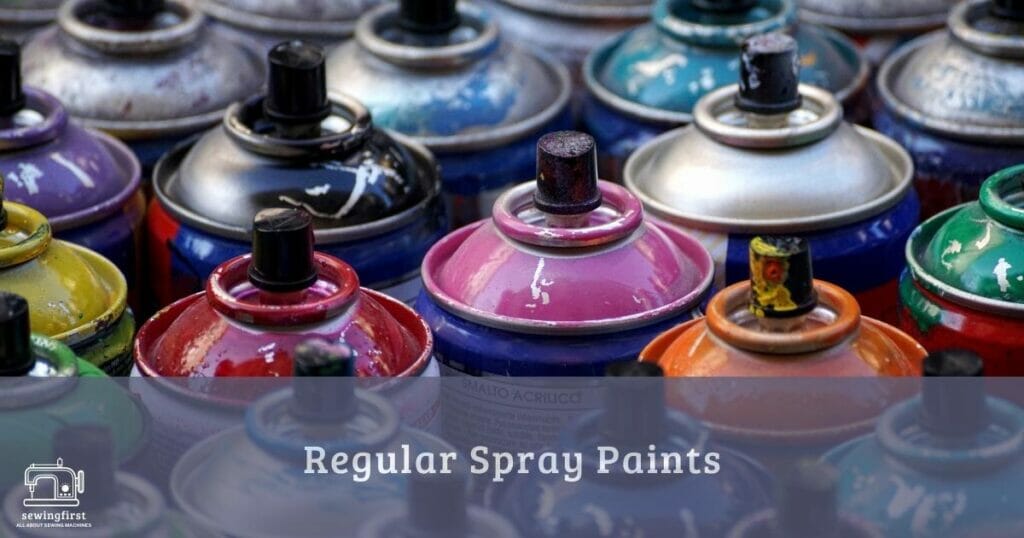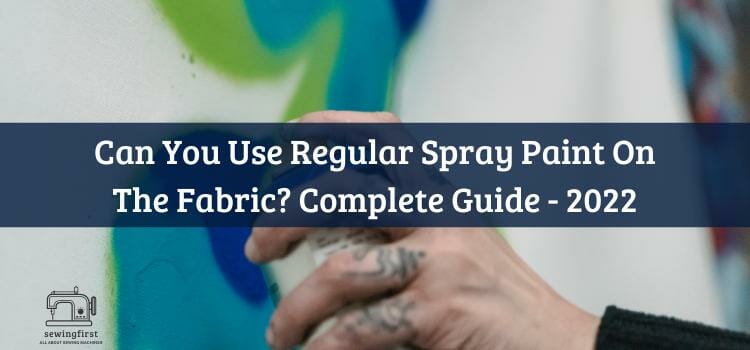Question: can you use regular spray paint on the fabric? Or perhaps you want to take a quick DIY project to the next level by adding some custom designs?
If you answered yes to either question, then read on because today I’ll show you exactly how to achieve both goals.
Yes! Regular spray paint is one of the easiest ways to give the fabric a makeover. Just choose the color you like best, apply it, let it dry, and voila!
But there are some things you should keep in mind. First, you’ll need primer. Second, you’ll need to choose a spray paint that’s compatible with the fabric you’ve chosen. Third, you’ll want to use a brush or roller to spread out the paint evenly.
Finally, you’ll want to wait for the paint to dry completely. If you follow those steps, you’ll end up with a beautiful piece of art that looks just like the original fabric. Read on to this guide on how to make the best use of regular spray paint.
Related Topic: How to Make a Sewing Machine Out of Cardboard: Amazingly Easy
Table of Contents
ToggleWhat Kind Of Regular Spray Paint You Can Use On Fabrics?

Soft Fabric Spray Paint
If you want to create unique designs on your clothes without damaging them, soft fabric spray paint might just be what you’re looking for.
This versatile product allows artists to create intricate patterns on almost anything, including T-shirts, jeans, jackets, bags, hats, shoes, and even furniture. You don’t even need to know how to draw; all you need is some patience and practice.
The best part about soft fabric spray paint is that it doesn’t damage fabrics. In fact, it actually makes them softer.
So, you won’t have to worry about ruining your favorite outfit because you accidentally spilled something on it. Plus, there are no fumes involved, making it safer for kids and pets.
You can find soft fabric spray paint at most craft stores, art supply shops, and online retailers.
Stencil Fabric Spray Paint
Stencil or line fabrics are similar to soft fabrics, but they’re made for use on stencils or lines. They may raise up from the clothes, or have a texture resembling that of screen spray paints.
It might be raised up from the clothing or have a texture similar either to screen printing paint or ink.
Metallic and glitter fabric paints are also available.
Multipurpose Spray Paint
They’re designed specifically for clothing and shouldn’t ever be applied to anything else. If you do want to paint something outside, make sure it’s well-ventilated.
Also, wear protective gear such as gloves, goggles, and long sleeves. And remember to keep children and pets out of the area while you’re working.
Metallic
If you want to add some metallic shine to your clothes, there are many ways to do it. You could go for a shiny fabric or use a metallic thread to sew something together. But metallic spray paint is easier to work with than those options.
The best part about metallic spray paint is that it’s easy to apply and remove.
Which Fabric Types Can Be Spray Painted?

The fabric should be prepped before spraying paint onto it. Certain fabrics cannot withstand the heat from an oven or dryer. And there are some paints that will damage the fabric if sprayed directly.
Here are some tips to help you choose the best fabric for spray painting.
100% Cotton
Cotton is one of the most popular fabrics used today because it is inexpensive, durable, and easily washable. However, cotton does not always make a good base for spray painting. If you are looking to do some quick decorating, spray painting cotton might not be the best option. In fact, there are many things you should know about spray painting cotton before trying out your hand at it.
The easiest way to cover up the texture of cotton is to apply a coat of primer first. Primer coats the surface of the fabric and helps the paint adhere better. Once the primer is applied, you can begin spraying.
Polycotton
Polycotton fabric is an ideal canvas for spraying paint. You can easily remove the paint after washing
The material is light, breathable, and soft against the skin. This makes it perfect for active wear such as yoga pants and sports bras. And since it doesn’t wrinkle like cotton, you don’t have to worry about ironing it either.
Wool
Spray painting wool is easy, though it requires some practice. You don’t want to ruin the look of your garment, so you’ll need to do some research beforehand.
If you are working with wool, you might consider using water-based acrylic paint instead of regular spray paint. These paints won’t dry as quickly and tend to stick to the wool fibers less.
Silk
The most beautiful fabric ever invented – silk – is now being sprayed onto walls, ceilings, furniture, and even clothing. But it’s not just for looks anymore; spray paint is a great way to express yourself creatively. And since you’re working with water-based paints, there are no fumes or toxic chemicals involved.
Linen
Linens are similar to cotton in terms of their ability to wrinkle and can also be used to create beautiful patterns.
Linen is highly absorptive, making it an excellent material for clothing and upholstery. Spray painters use linen because it’s easy to work with and has good absorption properties.
Polyester
Synthetic fabrics should never be sprayed with spray paint. Polyester fabric is one of the toughest materials around, but it doesn’t like being coated with anything sticky.
If you want to dye your polyester clothing, use fabric dyes. They are safe and easy to apply. You don’t even need to wash out the fabric afterward. Just let it dry naturally.
Spray Painting Tips For Fabrics
The process of spray painting involves mixing several chemicals into a liquid form. When mixed properly, it creates a thick, smooth coating. But, there are some things you should know about how to do it correctly.
First off, make sure to buy the correct type of spray paint for the fabric. Then, read up on the proper way to apply the paint.
Next, choose the best drying conditions for your project. You’ll want to keep the room dry, cool, and ventilated. And, once your project is completely dry, make sure to store it away safely.
And finally, remember that spray painting is a messy job. So, wear protective clothing and goggles. Also, clean up immediately afterward.
How To Cure Spray Painted Fabrics
For most fabrics, the standard drying time for sprayed-on paints is 2 hours. However, if you want them to be drier sooner, use acrylic spray paints instead.
They dry much quicker than oil-based ones. You can also add a few drops of water to help accelerate the drying process. However, avoid spraying directly onto wet fabrics. This will cause the paint to run and make the fabric look messy.
Optimum weather conditions for faster-drying paint include low relative humidity and hot temperature. Cold weather slows down the drying process while high relative humidity makes it harder for the paint to adhere to the fabric.
Use a dehumidifier to keep the air around the fabric cool and damp. Or, heat the room where you’re working.
Avoid painting too thickly or evenly on the fabric. Apply several thin coats to ensure the paint adheres properly.
A primer helps to bond the base coat to the fabric.
Regular Spray Paint on Fabric: Best Methods
There are several options for how to spray paint fabrics. Depending on the type of fabric you’re working with, there are a few different methods.
For example, If you’re spraying a cotton item such as a pillowcase, you’ll want to make sure you put some sort of barrier around the edges. Cotton is very absorbent, so you don’t want to accidentally soak the rest of the fabric.
Another thing to keep in mind is that cotton doesn’t take well water-based paints, so you might want to try something else.
If you’re spraying a polyester item, you’ll want to avoid getting any oil stains on the surface. Oil-based paints work better on polyester because they won’t stain the surface.
However, if you do spill oil onto a polyester item, just wipe it off immediately. Otherwise, it could cause permanent damage.
Another important factor to consider is whether or not the fabric is porous. If it is, you’ll want to use a primer. Primers help prevent the paint from bleeding into the pores of the fabric.
They also provide extra protection against fading. Once you’ve applied the primer, apply the base coat of color. Make sure to let it dry completely before applying another layer.
Once you’ve finished painting, let it dry overnight. Then, you can start adding accessories to complete the look.
Best Spray Paint For Fabric
Tulip ColorShot Instant Fabric Paints are perfect for beginners who want to start experimenting with spray paint. They dry fast and are easy to use.
Plus, you don’t have to worry about cracking the surface because it doesn’t crack easily under high temperatures as some paints do. This product is ideal for people who want to experiment with spray paint without having to invest too much money.
Watch this video on How to make a spray-paint logo on your T-shirt!
What is the Best Way to Remove Spray Paint from Clothing?
Removing spray paint from fabric isn’t difficult. You just need to know what works best. Here are some tips to help you out.
- You can saturate the surface by using any of these products: Mineral Spirits, Hot Pepper Sauce, Citrus Cleaner, Orange Oil Removing Solution, Rubbing Alcohol, Nail Polish Remover, or Watter.
- Let it sit for about 20 minutes before repeating the step again.
- Repeat steps 1 and 2 until the paint is no longer visible.
- Rinse the fabric thoroughly with water.
- Dry the fabric completely.
- Use a lint roller to remove any remaining residue.
- Apply a coat of clear sealant to protect the fabric.
- Wash the fabric as usual.
Here’s How to Care for Spray-painted Fabrics
When choosing spray paint for fabric, you must know what type of solvent you are using. Some paints contain solvents such as acetone and methylene chloride, while others use water-based solvents.
Acetone and methylene chloride are harmful chemicals that can cause respiratory problems as well as skin irritation. If you do decide to use spray paint, make sure to follow the manufacturer’s instructions carefully.
Preparation Before Spray Paint on Fabric
Ventilated Area
When spray painting, it’s important to make sure the area being sprayed is well-ventilated. This way, paint fumes don’t build up inside the room and cause headaches and nausea. You want to avoid breathing in the fumes because it could damage your lungs.
Also, make sure you wear a mask during the process. When you do, you won’t breathe in the paint fumes and risk getting sick.
Cover Areas
Spray painting can be a fun activity for kids, but it can also be dangerous. Kids often use spray paints without adult supervision and end up damaging walls, furniture, clothing, and themselves.
To protect against accidents like these, cover every area you don’t want to paint with masking tape. This way, kids won’t accidentally touch anything they shouldn’t.
Masks are useful for protecting small areas. If you’re doing a wall, put one over each window frame and doorframe. Then, work around those areas to avoid getting paint on ..your clothes or skin.
Protect yourself from the spray paint. Wear gloves, long sleeves and pants, goggles, and ear protection. Also wear shoes that aren’t easily stained.
How to Spray Paint Fabric: Step-by-Step Guide
1. Clean Up The Fabric And Cover The Surface.
Lay out an old shirt or another cloth on your work surface and use it to test your design.
To prevent overspray, spray the fabric before hanging it on the wall. Then wipe off the excess paint without pressing the material into the wall. When you’re done, hang the fabric using hangers or ropes.
2. Prepare Your Spray Bottle
When you’re ready to spray, make sure the bottle is completely full and there are no leaks. If you don’t want to waste water, try putting a piece of tape over one end of the bottle.
3. Spray Paint Your Fab
Hold the sprayer about one inch from your project and cover it evenly with a light coat of sprayable material. You don’t want too much material so that it drips down onto your surface.
4. Let Your Fabric Dry
Wet fabric shrinks during the drying process, especially if it’s been washed within 24 hours. If you want to avoid shrinking, let your laundry sit in the dryer longer than usual. You’ll find that the clothes are softer and feel better too.
5. Use spray paint fabric seals
Spray paint is one of those things that we all love to do, but hate to clean up afterward. If you don’t want to spend hours cleaning up every single piece of spray-painted furniture, try sealing it off with a clear coating. We’ve tested out seven different methods and found the best way to seal your spray paint fabric.
6. Considerations
There are different kinds of spray paints and liquid fabric paint products available today. Some contain volatile organic compounds (VOCs), while others do not.
If you plan to use spray paint outdoors, look for one without VOCs. Here are some tips on how to choose the best spray paint for your project.
- Choose a spray paint based on its application technique.
Spray paint comes in aerosol cans and bottles. Aerosols are generally used indoors, while bottles are usually found outdoors. Depending on where you want to apply your paint, you might want to buy a particular brand.
For example, aerosol cans are great for indoor projects because they don’t require much ventilation. However, aerosol cans aren’t suitable for outdoor applications because they emit harmful fumes. Bottles, on the other hand, are ideal for outdoor projects since they don’t release harmful fumes.
- Consider the material being sprayed
Some types of spray paint are better suited for certain materials. For instance, acrylic paint works well on wood, metal, glass, plastic, and ceramic surfaces.
Acrylic paint dries quickly, making it useful for quick touch-up jobs. Polyurethane spray paint is suitable for painting concrete and brick walls. Vinyl paint is designed for vinyl siding, fences, decks, and roofs.
- Check the label
The label on your spray paint container will tell you what ingredients are contained within the product. Look for a list of chemicals, including VOCs.
Most manufacturers will include information about the amount of VOCs emitted during the manufacturing process. As mentioned earlier, VOCs are harmful substances that can cause respiratory problems.
What Should You Know Before Purchasing Fabric Spray Paint
There are many different types of fabric spray paint available today. Some are designed specifically for fabrics while others work well on wood, metal, plastic, glass, ceramic, concrete, leather, and even rubber.
Most fabric spray paints come in either matte or glossy finishes. Matte finishes tend to provide better coverage and durability while glosses offer a shinier finish. Both options allow you to achieve a wide variety of looks.
Once you’ve chosen your favorite style, you’ll want to test it out yourself. Grab a piece of paper or cardboard and try spraying a small area. Then take note of how much coverage you achieved. If you don’t like the look, you can easily change it with another coat.
When choosing a brand, make sure it’s reputable. Look for brands that are certified by organizations such as the American Society for Testing Materials (ASTM). These certifications ensure that products meet certain standards and quality control measures. They also help protect consumers against poor-quality products.
Conclusion
Spray paint is versatile and easy to use no matter which type of surface you’re working on. It’s easy to apply regardless of whether you’re using an indoor or outdoor surface.
So, now by reading this whole guide you can get started with spray painting! Remember to always read the instructions carefully before beginning any project.
FAQs
Do Spray Paints On Fabrics Fade?
Yes, spray paint will eventually rub off if you don’t use anything to protect it. That’s why you must seal it with something like an acrylic spray or embroidery flax sealer after applying it to prevent it from rubbing off.
Do Spray Paints Become Permanent On Fabric?
Most spray paints don’t hold up well when exposed to sunlight and high temperatures for long periods of time. Some spray paint products, however, can withstand these conditions.





